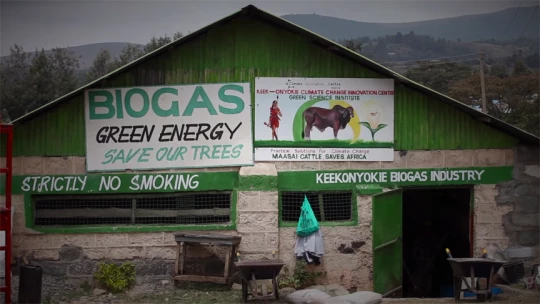Growing up, I always dreaded to enter my grandmother’s kitchen in the village. She used firewood to cook: There was such a dark, thick smoke in the room that I couldn’t breathe or keep my eyes open. I really don’t know how my grandmother could spend hours and hours in there, every day, for so many years. And unfortunately, my grandmother is not an isolated case. More than 90 percent of Kenya’s population uses firewood, charcoal or kerosene for their daily cooking needs.
I always dreamed that clean sources of energy would make Kenyans more independent and less exposed to the serious health risks posed by fossil fuels. In rural areas, most women like my grandmother rely on firewood; its consumption not only depletes our forests but also emits hazardous smoke that causes indoor pollution and eventually respiratory illness. In areas where firewood is scarce, women have to use cow dung as fuel, an option possibly even worse in terms of pollution. Urban areas are affected too: The poor rely mostly on charcoal, another biomass that has the same negative effects and health risks of firewood.
Cleaner fuel options have already been developed but are often too expensive or too difficult to transport across the country to be adopted by a large part of the population, especially by the 40 percent of people at the base of the pyramid.
So what can be done? How can we make clean fuels more affordable and accessible?
I first heard about bottled biogas when I visited a "green" slaughterhouse in Kiserian, Kenya. I was really impressed: My dream of a cleaner, more affordable and easily accessible fuel was right there before my eyes.
The Keekonyoike Slaughterhouse found an innovative way to produce affordable biogas and package it for distribution all around the country. Using a special bio-digester, this business can turn blood and waste from a community-based Maasai slaughterhouse into biogas for cooking. To facilitate transport, the firm stores the fuel in recycled cylinders and used tires, reducing even further the environmental impact of the operation. Just to give me a better idea of the "green" potential of his business, the manager told me that this first biogas plant is expected to cut methane emissions by more than 360,000 kilograms per year (the equivalent of almost 2,000 passenger vehicles).
Indeed, "bottled" biogas (biogas compressed into a cylinder) has huge potential in Kenya: Farmers can directly produce it, recycling the waste from their farms; can use it for their cooking needs; and, thanks to the bottling process, can sell the excess on the local market, generating income while saving the environment.
Keekonyokie is a company that began operations in 1982. It runs an abattoir that slaughters about 100 cows per day to meet the meat demand in Nairobi and its environs. In 2008, with the support from GTZ, the company constructed two 20-foot-deep biogas digesters that would help manage the abattoir waste, which was becoming a menace and a health hazard. Within a short time, the biogas being produced from the digesters was more than the company could absorb. The company managers started thinking of compressing and bottling the excess biogas, but they needed support to test the technical and commercial viability of their idea.
When infoDev’s Kenya Climate Innovation Center (KCIC) opened its doors in October 2012, Keekonyokie was one of the first companies to be admitted.
Thanks to the services provided by the Kenya CIC, Keekonyokie has refined its product and is now ready to enter the national market. The first cylinders will be available at the end of this month at an initial cost of Ksh 3,700 (US$44) for the 6kg-cylinder and Ksh 700 (US$8) for a single refill - exactly half the cost of a similar quantity of LPG.
The initial production capacity for the bottled biogas will be 100 cylinders per day which will be available through outlets in Kiserian, Ngong and Ongata Rongai. As it is, the indicative demand for the gas is much more than what can be produced. The good news is that Keekonyoike now has a 30-acre piece of land where they want to put up an abattoir that is five times bigger than the current plant, which will translate to five times more biogas production.
The potential of this locally relevant solution is great and goes way beyond the reduction in methane emissions. A group of talented women from Kenya’s largest slum produces yogurt to earn income. After hearing of Keekonyoike’s biogas, they are planning to replace firewood with bottled biogas in the sterilization process of their yogurt. They were so impressed by this innovative idea that they have dubbed it "okoa mama" ("save mothers") in recognition of its immense value to the urban poor, who struggle to gain access to clean and affordable fuel. The women are also considering partnering with Keekonyokie and becoming distributors of the bottled gas in the slum. They are sure that this affordable and portable form of biogas will be a big hit in their local communities.
Hopefully, with the support of the Kenya CIC, innovative clean-tech ventures like this can keep growing and can provide locally relevant solutions to climate change while creating jobs and improving lives. The center has been supporting local climate-tech ventures - there are already more than 80 - with financing mechanisms, advisory services and targeted policy support aimed at creating greater incentives for the adoption of clean fuels.
Thanks to bottled biogas and many other clean fuels being tested and developed with the support of the Kenya CIC, hundreds of women like my grandmother can finally cook for their families in a healthy environment, with no smoke, cough or tears in their eyes.



Join the Conversation